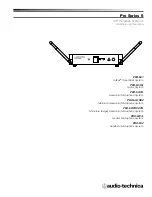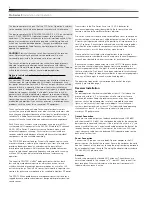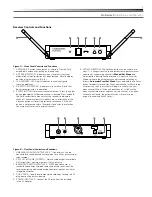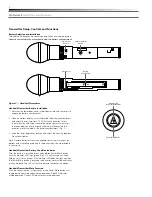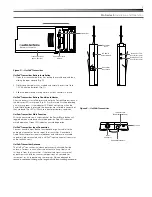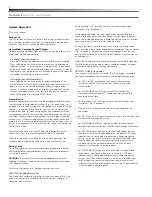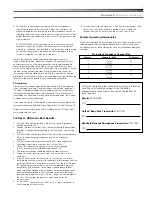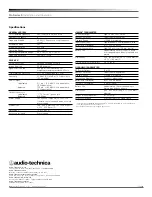
Pro Series 5
Installation and Operation
7
6. For MIC: While again speaking/singing into the microphone at
typically loud levels, adjust the mixer’s input trim control so the
highest sound pressure level going into the microphone causes no
input overload in the mixer, and yet permits the mixer’s channel and
output level controls to operate in their “normal” range (not set too
high or too low).
For INSTRUMENT: While again playing the instrument at typically
loud levels, adjust the receiver’s AF Level control so the highest
signal level causes no input overload in the instrument amplifier and
yet permits the amplifier’s input level controls to operate in their
“normal” range (not set too high or too low).
Note: If the mixer cannot be adjusted to operate in its normal
range without distortion, adjust the receiver’s AF Level control (turn
counterclockwise) until the mixer/amplifier is no longer overloaded.
Note: RF power may be set to high or low via the RF Power Select
switch on the side of the UniPak
®
transmitter. (Fig. D on page 5). While
the high setting normally provides maximum operating range, the
low setting will help extend battery life. The low setting may also be
preferred in multi-channel systems, or when operating very close to the
receiver, to reduce the possibility of interference or overload.
RF Interference
Please note that wireless frequencies are shared with other radio ser-
vices. According to Federal Communications Commission regulations,
“Wireless microphone operations are unprotected from interference
from other licensed operations within the band. If any interference is
received by any Government or non-Government operation, the wireless
microphone must cease operation...”
If you need assistance with operation or frequency selection, please con-
tact your dealer or the Audio Solutions Department at Audio-Technica U.S.
Extensive wireless information also is available on the A-T Web site at
www.audio-technica.com.
Ten Tips to Obtain the Best Results
1. Use only fresh alkaline batteries. Do not use “general purpose”
(carbon-zinc) batteries.
2. Position the receiver so that it has the fewest possible obstructions
between it and the normal location of the transmitter. Line-of-sight
is best.
3. The transmitter and the receiver must be set to the same frequency.
Set or change transmitter frequency only when its power is
turned off.
4. The transmitter and the receiver should be as close together as
conveniently possible, but no less than six feet (2 m.).
5. Yellow LED indicates the channel is set to service position
(0 or 9); please select a valid operating channel (1-8).
6. The receiver antennas should be kept away from any metal.
7. A receiver cannot receive signals from two transmitters at the
same time.
8. If the AF Level control of the receiver is set too high, it may over-
drive the input of the mixer or clip the output of the receiver, causing
distortion. Conversely, if the receiver output is set too low, the over
all signal-to-noise ratio of the system may be reduced. Adjust the
output level of the receiver so the highest sound pressure level
going into the microphone (or the loudest instrument playing level)
causes no input overload in the mixer, and yet permits the mixer
level controls to operate in their “normal” range (not set too high or
too low). This provides the optimum signal-to-noise for the
entire system.
9. In the UniPak
®
transmitter, the “Mic” or “Inst” input control not in
use should be set to minimum.
10. Turn the transmitter off when not in use. Remove the battery if the
transmitter is not to be used for a period of time. Unplug the
receiver from the AC outlet when the system is not in use.
System Operating Frequencies
Each transmitter/receiver system operates on a choice of eight switch-
selected frequencies. Available frequencies are shown in the chart.
All frequencies may be combined for up to 8 simultaneous operating
channels.
Pro Series 5 Frequency Channel Plan
Channel
Frequency - MHz
TV Channel
1
542.125
26
2
545.750
3
551.500
27
4
552.000
5
557.875
28
6
559.375
7
560.500
29
8
561.250
For future reference, please record your system information
here (the serial numbers appear inside the battery
compartment of each transmitter, and on the bottom of
each receiver):
Receiver
PRO-R500
S/N
UniPak
®
Body-Pack Transmitter
PRO-T501
S/N
Handheld Dynamic
Microphone Transmitter
PRO-T502
S/N

